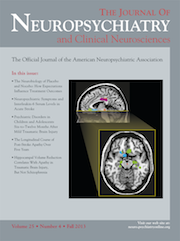Tardive Dyskinesia Induced by a Switch From Haloperidol Depot to Paliperidone Palmitate
To the Editor: Tardive dyskinesia (TD) is a movement disorder that can occur during antipsychotic medication use, occasionally after many months, but, more commonly, after years.1 It is usually associated with older patient age, female gender, longer duration, and higher dosages of antipsychotic treatment, concurrent affective disorders, and greater severity of the psychotic disorder.2 With the increasing use of atypical antipsychotics, fewer cases and less severe symptoms of TD have been seen.3 For this reason, patients on typical antipsychotics are generally switched to atypical antipsychotics if possible. Furthermore, there is evidence that atypical antipsychotics may improve TD symptoms without causing progression of this disorder.4 We report here an unusual condition in which a schizophrenic patient developed TD after switching her antipsychotic medication from haloperidol depot to paliperidone palmitate. The TD was then successfully resolved by using aripiprazole instead.
Case Report
A 39-year-old Han Chinese woman presented with her first psychotic episode at age 29. Her height was 155 cm., and her weight was around 63 kg. Her body mass index was 26.2. It was not before the age of 38 that she had her first antipsychotic treatment, when she was involuntarily brought to our community clinic. She was then given regular haloperidol depot treatment (40 mg per month) for 9 months. Because of the prominent negative symptoms, haloperidol depot was discontinued and replaced with paliperidone palmitate.
She then received an initial dose of paliperidone palmitate 100 mg, followed by a second dose of 100 mg at Day 8. She was then maintained on paliperidone palmitate 100 mg, which she received at monthly intervals for 2 months. She tolerated the medication well, and her negative symptoms improved. At the period subsequent to the fourth dose of 100 mg, the first mild tongue protrusion was noted. The symptoms progressed over the course of the next month to involuntary movements of her tongue and jaw, which were of moderate-to-severe intensity. Her routine biochemical tests were unremarkable. There was no family history of movement disorder. She was distressed by the movements, and there had been a notable decline in her daily life functioning.
Paliperidone palmitate was immediately discontinued, and she was restarted on oral aripiprazole 5 mg daily. She began to demonstrate some improvement at 6 weeks after taking aripiprazole. At 3 months, her movement symptoms remitted after the drug conversion, and her psychiatric symptoms remained controlled.
Discussion
One distinctive characteristic observed in this case is that TD occurred after switching from typical to atypical long-acting antipsychotic injection. Withdrawal-emergent dyskinesia (WED) may play an important role in the pathogenesis. WED happens when patients have their dosages of antipsychotic medication either decreased or discontinued, causing lower dopamine D2-receptor blockade; abnormal movement may appear for the first time or worsen temporarily.5 Haloperidol has high dopamine D2-receptor affinity, and D2 receptors tend to be up-regulated after lengthy exposure.6 Paliperidone is known to possess a faster dissociation speed than haloperidol, which may contribute to lower D2-receptor blockade.7 When paliperidone is introduced, a relatively weak D2 blockade might have down-regulated the D2 receptors, thereby inducing WED.
We might consider another possibility: that the main cause of TD development is the use of paliperidone palmitate. In the literature review, there was one longer-term trial regarding the maintenance treatment of paliperidone palmitate in schizophrenia patients, in which a case of TD was reported.8 Lally et al. have also reported a patient with paranoid schizophrenia who developed orofacial TD after 4-month treatment with paliperidone palmitate.9 Also, the occurrence of TD in association with oral paliperidone has been reported in a small number of case reports.10,11 Several demographic and clinical factors are known to increase the risk of TD.2 This present case has the risk factors of being female and having been exposed to 9 months of typical antipsychotic medication with relatively higher dosage. Although paliperidone is an effective atypical antipsychotic medication with a lower risk of extrapyramidal syndromes,12 adverse effects such as TD may still occur.
Since atypical antipsychotics are increasingly used in schizophrenia patients, we should be aware of their potential for WED, especially when switching from a typical antipsychotic with a higher dopamine D2-receptor blockade, such as haloperidol, to an agent with a relatively lower D2-receptor blockade, such as paliperidone. Lastly, aripiprazole demonstrates superior efficacy in reducing TD, as in our case.
1 : Tardive dyskinesia in the era of typical and atypical antipsychotics, part 2: incidence and management strategies in patients with schizophrenia. Can J Psychiatry 2005; 50:703–714Crossref, Medline, Google Scholar
2 : Epidemiology and risk factors for (tardive) dyskinesia. Int Rev Neurobiol 2011; 98:211–230Crossref, Medline, Google Scholar
3 : Incidence of tardive dyskinesia with typical versus atypical antipsychotics in very high risk patients. Biol Psychiatry 2003; 53:1142–1145Crossref, Medline, Google Scholar
4 : Can atypical antipsychotics improve tardive dyskinesia associated with other atypical antipsychotics? case report and brief review of the literature. J Psychopharmacol 2010; 24:1121–1125Crossref, Medline, Google Scholar
5 : Withdrawal-emergent dyskinesia in patients with schizophrenia during antipsychotic discontinuation. Biol Psychiatry 1995; 38:713–719Crossref, Medline, Google Scholar
6 : Dopamine D2 receptors in the striatum and frontal cortex following chronic administration of haloperidol. Neuropharmacology 1987; 26:481–483Crossref, Medline, Google Scholar
7 : Oral paliperidone extended-release: chemistry, pharmacodynamics, pharmacokinetics, and metabolism, clinical efficacy, safety, and tolerability. Expert Opin Drug Metab Toxicol 2012; 8:873–888Crossref, Medline, Google Scholar
8 : Paliperidone palmitate maintenance treatment in delaying the time-to-relapse in patients with schizophrenia: a randomized, double-blind, placebo-controlled study. Schizophr Res 2010; 116:107–117Crossref, Medline, Google Scholar
9 : A case of paliperidone-palmitate-induced tardive dyskinesia. Gen Hosp Psychiatry 2012; 35:213; available at doi: 10.1016/j.genhosppsych.2012.04.009Medline, Google Scholar
10 : Oral-paliperidone-induced tardive dyskinesia: a case report. Gen Hosp Psychiatry 2012; 34:e5–e6Crossref, Medline, Google Scholar
11 : Paliperidone-related rabbit syndrome. J Clin Psychopharmacol 2011; 31:379–380Crossref, Medline, Google Scholar
12 : A randomized, placebo-controlled study to assess the efficacy and safety of 3 doses of paliperidone palmitate in adults with acutely exacerbated schizophrenia. J Clin Psychopharmacol 2011; 31:379–380Crossref, Medline, Google Scholar



